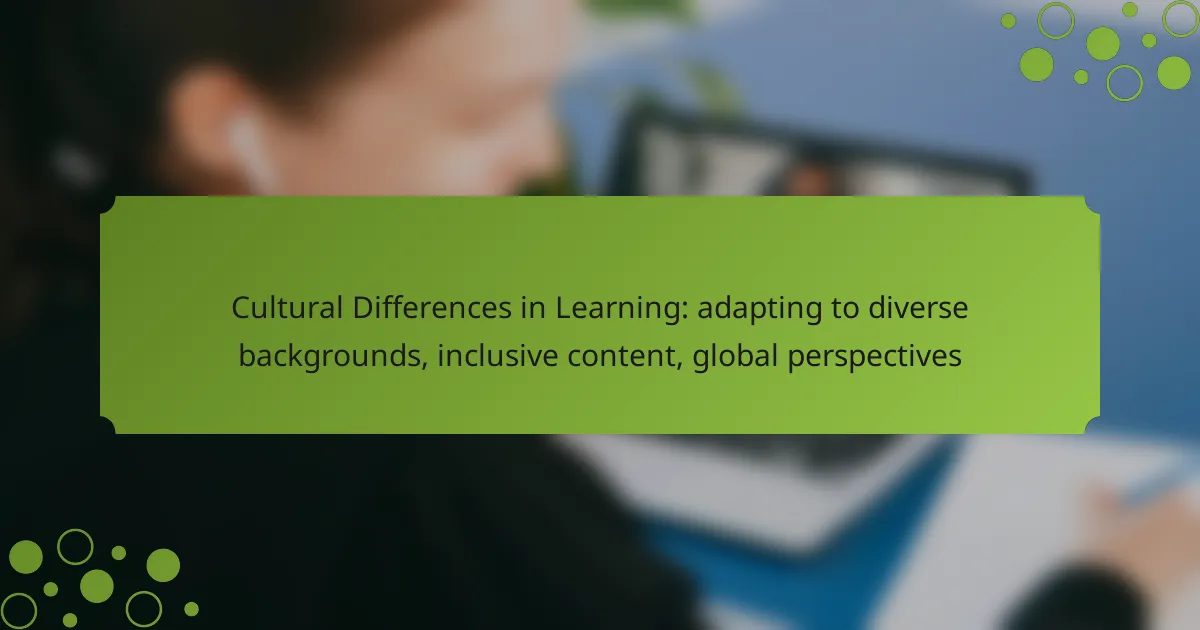
In an increasingly interconnected world, recognizing and adapting to cultural differences in learning is essential for effective education. By embracing diverse educational approaches and integrating culturally relevant content, educators can create inclusive environments that cater to students from various backgrounds. This not only enhances engagement but also ensures that all learners feel represented and valued in their educational journeys.
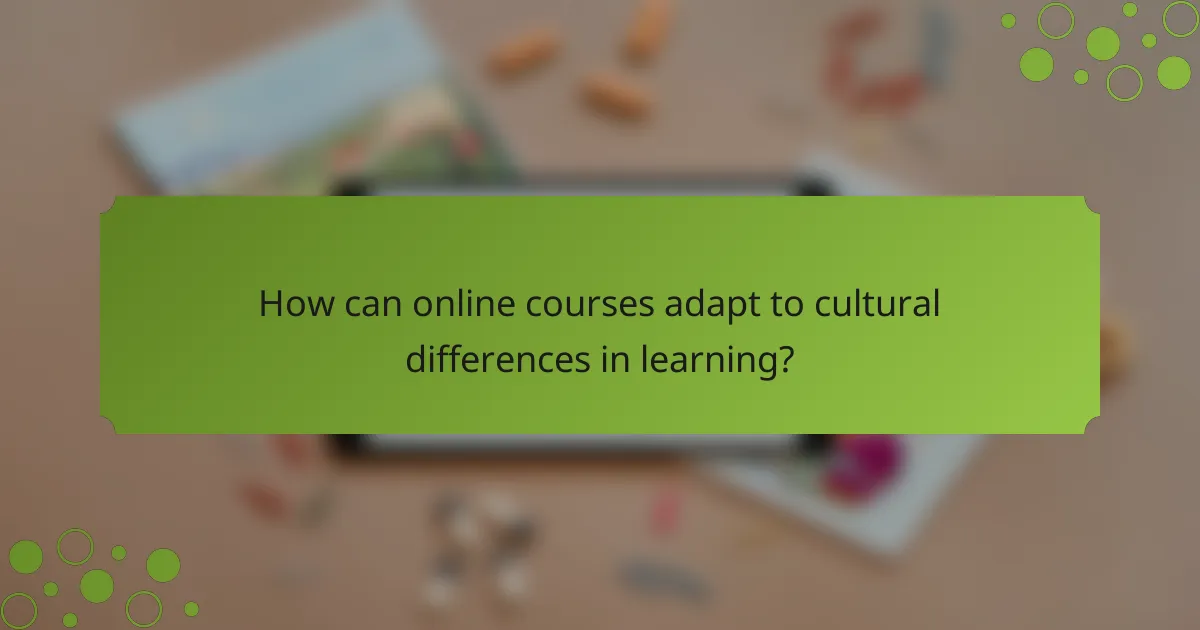
How can online courses adapt to cultural differences in learning?
Online courses can adapt to cultural differences in learning by embracing diverse educational approaches, integrating culturally relevant content, and providing support for various languages. This ensures that learners from different backgrounds can engage meaningfully with the material and achieve their educational goals.
Incorporating diverse teaching methods
Diverse teaching methods cater to various learning preferences and cultural backgrounds. For instance, some cultures may favor collaborative learning, while others might emphasize individual study. Incorporating a mix of instructional strategies, such as group projects, discussions, and multimedia presentations, can enhance engagement and understanding.
Consider using methods like experiential learning, which allows students to apply concepts in real-world scenarios. This approach can resonate well with learners who value practical applications of knowledge.
Utilizing culturally relevant examples
Using culturally relevant examples in course materials helps learners relate to the content. This could involve incorporating case studies, historical references, or scenarios that reflect the students’ cultural contexts. For example, a business course might analyze local companies or economic conditions relevant to the learners’ regions.
When selecting examples, aim for inclusivity by representing a variety of cultures and perspectives. This not only enriches the learning experience but also fosters a sense of belonging among students.
Offering multilingual support
Providing multilingual support is crucial for accommodating learners who speak different languages. This can include offering course materials, subtitles, and assessments in multiple languages. For instance, a course could be available in English, Spanish, and Mandarin to reach a broader audience.
Utilizing translation tools and services can help ensure that content is accurately conveyed. Additionally, consider hiring multilingual instructors or facilitators who can assist learners in their preferred language.
Implementing flexible learning styles
Flexibility in learning styles allows students to choose how they engage with course content. This could mean offering asynchronous options, where learners can access materials at their convenience, or synchronous sessions that accommodate different time zones.
Encourage students to select their preferred formats, whether through video lectures, written materials, or interactive activities. This adaptability can significantly enhance the learning experience and cater to individual needs.
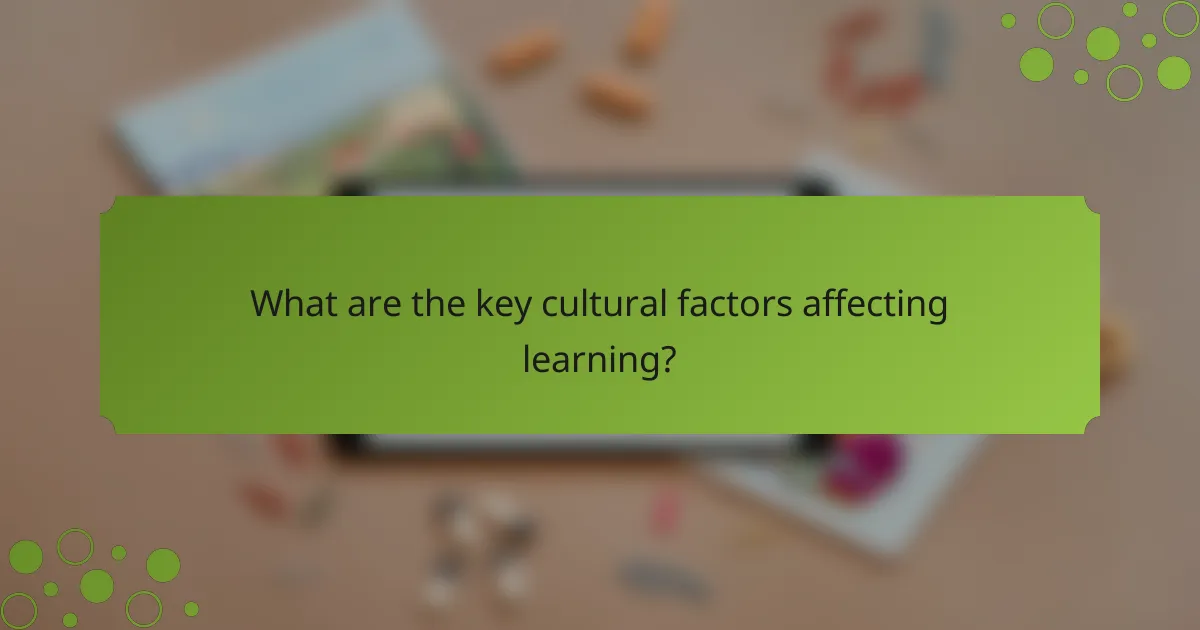
What are the key cultural factors affecting learning?
Cultural factors significantly influence learning by shaping communication, preferences, collaboration, and authority perceptions. Understanding these elements helps educators create inclusive and effective learning environments that cater to diverse backgrounds.
Communication styles
Communication styles vary widely across cultures and can impact how information is shared and understood. For instance, some cultures may favor direct communication, while others may prefer a more indirect approach, valuing context and non-verbal cues.
Educators should be aware of these differences and adapt their communication methods accordingly. For example, in cultures that value indirect communication, providing context and allowing for pauses can facilitate better understanding.
Learning preferences
Learning preferences are influenced by cultural backgrounds, with some cultures emphasizing rote memorization while others prioritize critical thinking and problem-solving. Recognizing these preferences can help tailor teaching methods to better suit diverse learners.
In practice, incorporating a mix of teaching strategies—such as hands-on activities, group discussions, and visual aids—can cater to various learning styles. This approach not only enhances engagement but also fosters a deeper understanding of the material.
Value of collaboration
The value placed on collaboration can differ among cultures, affecting group dynamics and teamwork in learning settings. In collectivist cultures, collaboration is often seen as essential, while individualistic cultures may emphasize personal achievement.
To support collaborative learning, educators should create opportunities for group work that respect cultural values. Encouraging peer feedback and shared projects can enhance the learning experience and build a sense of community among students.
Attitudes towards authority
Attitudes towards authority figures, such as teachers and instructors, can shape students’ engagement and participation in learning. In some cultures, respect for authority is paramount, leading to a more passive learning style, while others may encourage questioning and debate.
Educators should consider these attitudes when designing their teaching approaches. For instance, in cultures with a high regard for authority, establishing a respectful rapport can encourage student participation, while in more egalitarian cultures, fostering open dialogue may be more effective.
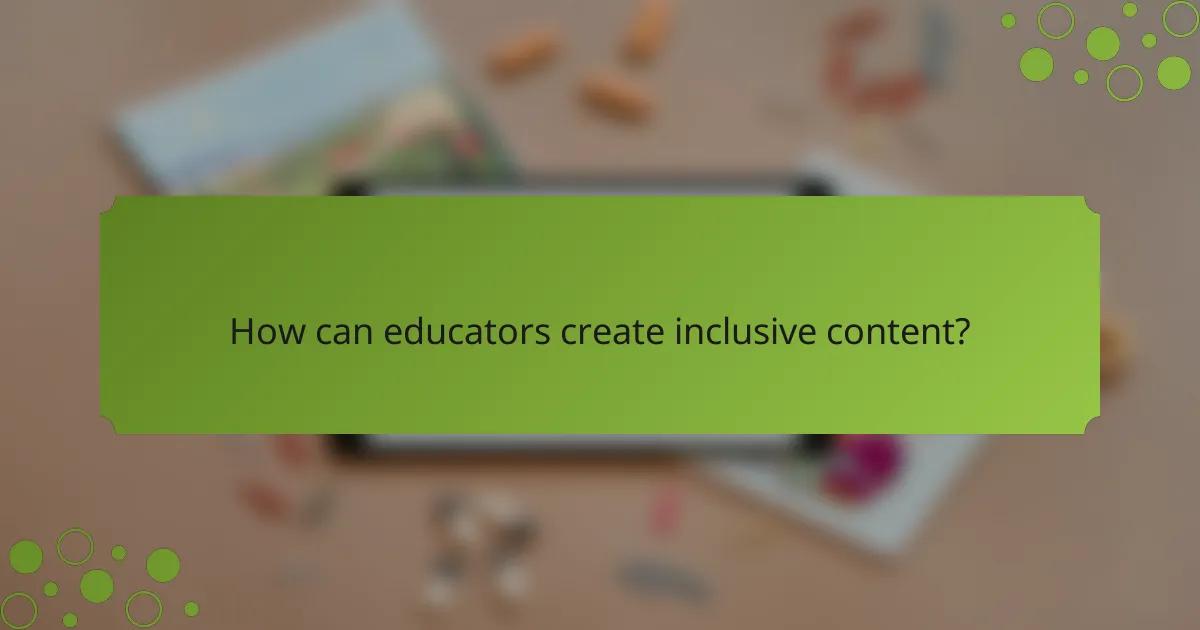
How can educators create inclusive content?
Educators can create inclusive content by integrating diverse perspectives, actively seeking student feedback, and adapting assessments to accommodate various learning styles. This approach fosters an environment where all students feel represented and valued, enhancing their educational experience.
Using diverse perspectives in curriculum
Incorporating diverse perspectives in the curriculum involves selecting materials and topics that reflect a variety of cultures, histories, and viewpoints. This can include literature from authors of different backgrounds, case studies from various countries, and discussions on global issues that impact different communities.
For example, when teaching history, educators might include narratives from indigenous peoples alongside traditional historical accounts. This not only enriches the learning experience but also helps students appreciate the complexity of different cultures.
Incorporating student feedback
Gathering and incorporating student feedback is crucial for creating inclusive content. Educators can use surveys, suggestion boxes, or open discussions to understand students’ needs and preferences regarding course materials and teaching methods.
For instance, if students express a desire for more representation in reading materials, educators can adjust their curriculum to include texts that resonate with a broader audience. This responsiveness fosters a sense of belonging among students.
Adapting assessments for inclusivity
Adapting assessments for inclusivity means designing evaluation methods that accommodate diverse learning styles and backgrounds. This can involve offering multiple formats for assessments, such as written, oral, or project-based evaluations.
Additionally, providing clear instructions and examples can help ensure that all students understand what is expected of them. Educators should also consider allowing extra time or alternative settings for students who may need them, ensuring fairness in evaluation.
Highlighting global case studies
Highlighting global case studies allows students to connect theoretical concepts with real-world applications across different cultures. By examining case studies from various countries, students can gain insights into how different societies address similar challenges.
For example, a business course might analyze successful companies from both developed and developing nations, showcasing diverse strategies and outcomes. This not only broadens students’ perspectives but also prepares them for a globalized workforce.
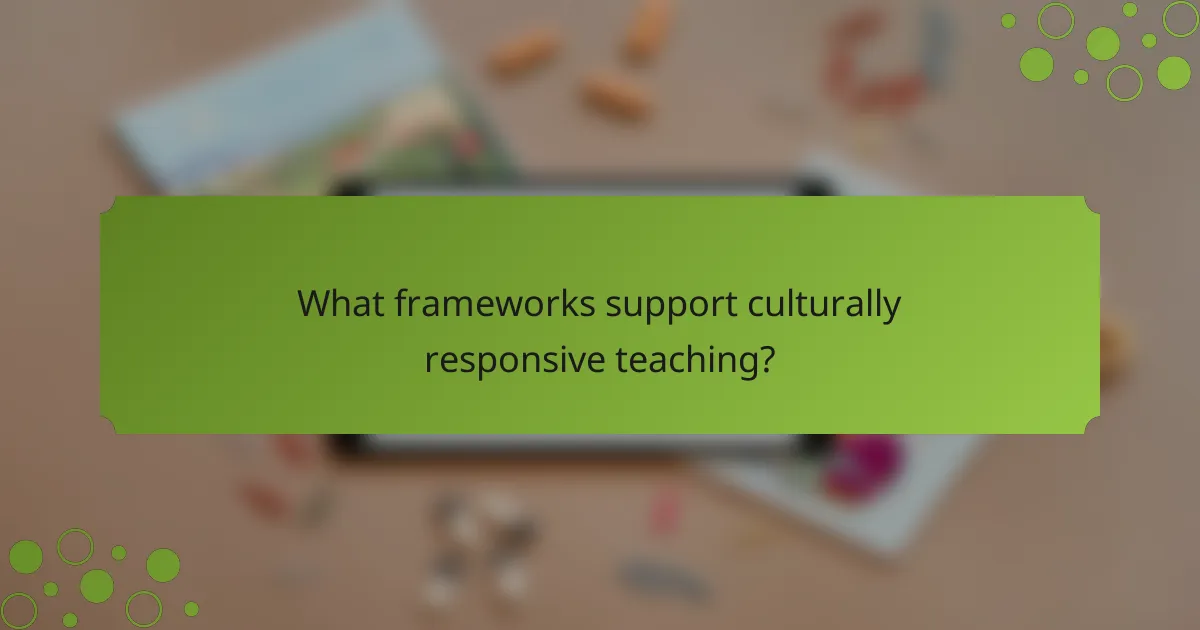
What frameworks support culturally responsive teaching?
Culturally responsive teaching is supported by various frameworks that emphasize inclusivity and respect for diverse backgrounds. These frameworks guide educators in creating learning environments that recognize and value students’ cultural identities.
Understanding by Design (UbD)
Understanding by Design (UbD) is a framework that focuses on backward planning in curriculum development. It encourages educators to start with desired learning outcomes and then design assessments and instructional strategies that align with those goals.
Incorporating culturally responsive elements into UbD involves considering students’ cultural contexts when defining learning objectives. For example, educators might include local histories or culturally relevant examples in their assessments to enhance engagement and understanding.
Culturally Relevant Pedagogy
Culturally Relevant Pedagogy is an educational approach that seeks to empower students by connecting learning to their cultural experiences. This framework emphasizes the importance of students’ cultural backgrounds in shaping their learning processes and outcomes.
To implement culturally relevant pedagogy, educators should integrate diverse perspectives into the curriculum and create a classroom environment that respects and celebrates differences. This might include using literature from various cultures or discussing historical events from multiple viewpoints.

How do global perspectives enhance learning experiences?
Global perspectives enhance learning experiences by exposing students to diverse viewpoints and cultural contexts, which enrich their understanding of complex issues. This approach encourages learners to think critically and develop a more nuanced worldview.
Broadening worldviews
Broadening worldviews involves integrating various cultural narratives and practices into the learning process. This can be achieved through diverse reading materials, case studies, and collaborative projects that include international perspectives.
For instance, a history lesson that includes multiple countries’ viewpoints on a significant event can help students appreciate the complexity of historical narratives. Incorporating global literature can also provide insights into different cultural values and beliefs.
Encouraging critical thinking
Encouraging critical thinking is essential when engaging with global perspectives. Students learn to analyze information from multiple angles, questioning assumptions and evaluating evidence. This skill is vital for navigating today’s interconnected world.
Teachers can facilitate this by posing open-ended questions that require students to consider various cultural contexts. For example, discussing a global issue like climate change can prompt students to explore how different countries prioritize environmental policies based on their unique circumstances.
Fostering empathy and understanding
Fostering empathy and understanding is crucial in a multicultural learning environment. By learning about different cultures, students develop a deeper appreciation for the experiences and challenges faced by others. This emotional connection can lead to more respectful and inclusive interactions.
Activities such as cultural exchange programs or virtual collaborations with peers from different countries can enhance this empathy. Such experiences allow students to share their stories and learn from each other, ultimately promoting a sense of global citizenship.
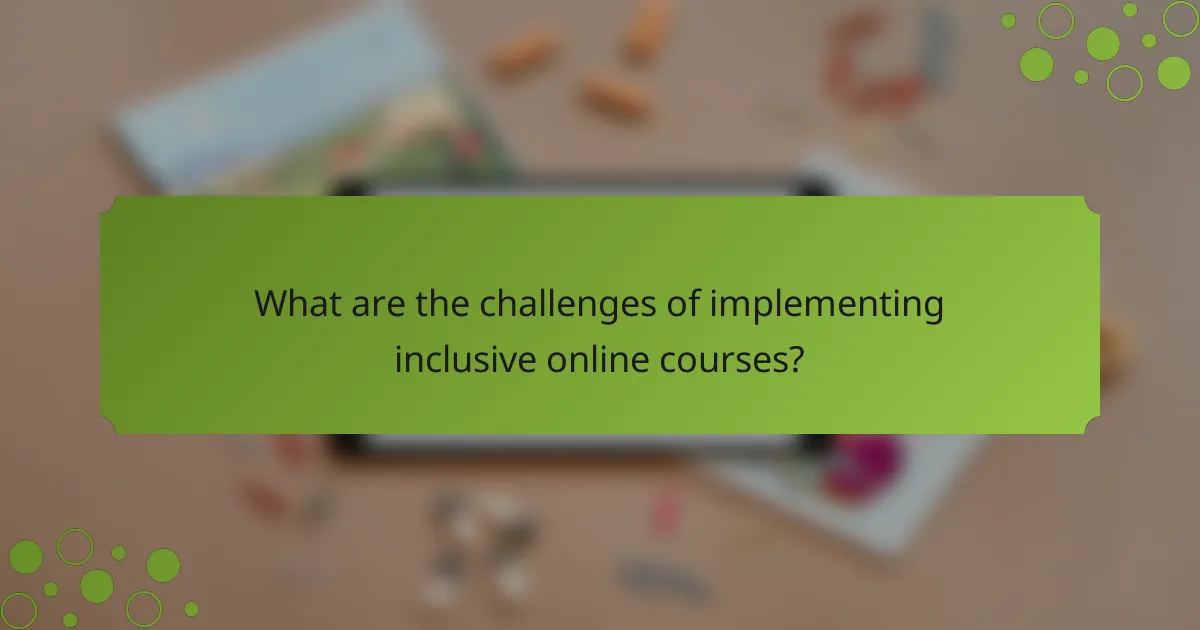
What are the challenges of implementing inclusive online courses?
Implementing inclusive online courses presents several challenges, including resource limitations, cultural differences, and the need for diverse content. These factors can hinder the development of courses that effectively address the needs of all learners.
Resource limitations
Resource limitations significantly impact the ability to create inclusive online courses. Institutions may struggle with insufficient funding, lack of access to technology, or limited expertise in developing diverse content. These constraints can lead to a one-size-fits-all approach that fails to accommodate various learning styles and backgrounds.
To overcome resource limitations, institutions should prioritize collaboration and sharing of resources. For example, partnering with organizations that specialize in inclusive education can provide access to valuable materials and training. Additionally, utilizing open educational resources (OER) can help reduce costs while enhancing course content.
It is essential to assess the available resources regularly and seek external funding opportunities, such as grants or sponsorships. Institutions can also encourage faculty to participate in professional development programs focused on inclusive teaching practices, ensuring that educators are equipped to meet diverse learner needs.


